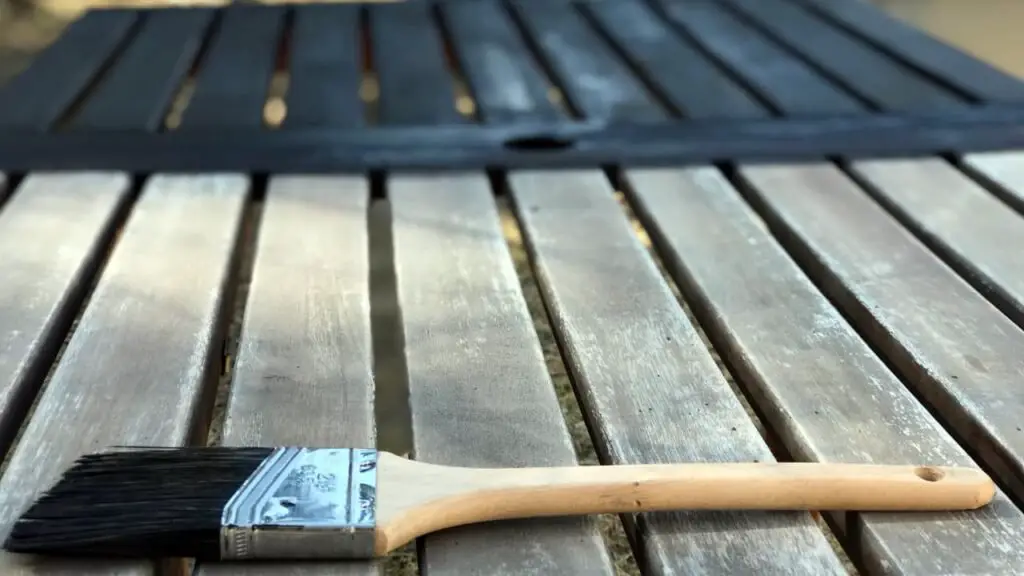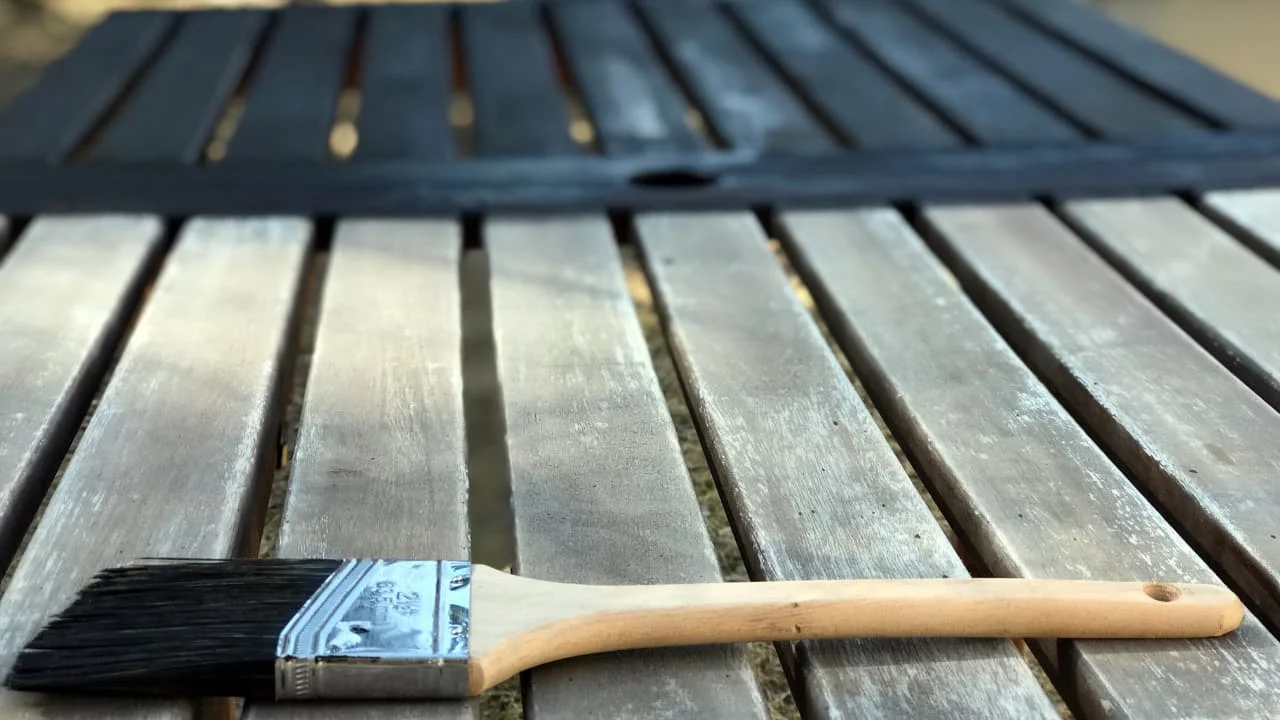Are you looking to give new life to your stained wood furniture or surfaces? You’re in the right place! Painting over stained wood can be a cost-effective and stylish way to elevate thrift store finds into timeless art pieces.
In this blog, we’ll explore the factors that affect paint adhesion on stained wood, the proper preparation steps you need to follow, and share some expert tips for achieving a flawless finish.
Key Takeaways 💭
- Yes, you can paint over stained wood, but proper preparation is crucial for adhesion and durability.
- Choosing the right type of paint and finish, such as latex or oil-based, chalk or milk paint, depends on personal preference and the intended use of the painted surface.
- Properly cleaning and sanding the stained surface before painting is essential for optimal results.
- Applying multiple coats of paint and a protective finish will extend the lifespan of your painted furniture or surfaces.
Table of Contents
Can You Paint Over Stained Wood?
Yes, you can paint over stained wood but there are several factors to consider before doing so such as the condition of the surface, the type of stain used, and the desired finish.

Factors To Consider Before Painting
Before diving into the painting process, it’s crucial to evaluate several factors that can impact the final outcome of your project. For instance, you should consider the type and condition of the stained wood surface you plan to work on.
If it has a very glossy finish or a heavily varnished finish, paint adhesion may become an issue without proper preparation.
Another aspect to take into account is selecting an appropriate color scheme for both aesthetic appeal and practical purposes. Keep in mind that darker stains might require more than two coats each of lighter-colored paints for complete coverage and uniformity across the entire surface.
Proper Preparation Steps
Before painting over stained wood, it’s crucial to properly prepare the surface for primer paint. This includes cleaning and sanding the wood to ensure that the paint will adhere correctly.
Begin by wiping down the stained surface with a damp cloth to remove any dirt or debris that could interfere with adhesion.
It’s also important to consider using a primer before painting on top of stained wood. A good quality primer helps increase adhesion and prevents staining from bleeding through newly applied paint layers.
If you’re unsure about what type of primer is best for your project, consult with an expert at your local hardware store or follow manufacturer recommendations based on the type of paint you plan on using.
Cleaning And Sanding The Surface
Properly cleaning and sanding the stained surface is essential to ensure the adhesion of the new paint. Start by using a soft-bristled brush or vacuum to remove any debris or dust on the surface.
Once cleaned, it’s time to go light sanding the surface carefully. Using fine-grit sandpaper (such as 120-220 grit), gently scuff up the entire surface in a circular motion until you’ve removed any bumps or imperfections.
Wipe off all sanding residue before painting begins for better adhesion. In case you find some areas where stains remained after the sanding process, consider applying primer specifically made for painted surfaces atop these spots before further painting; such primers seal stains from bleeding through the fresh paint over them later on.
Best Paints And Finishes For Painting Stained Wood
Latex paint, oil-based paint, chalk paint, and milk paint are the four best types of paints and finishes for stained wood.
Latex Paint
Latex paint is a popular choice for painting over stained wood due to its ease of use and quick drying time. It can be applied without the need for any special tools or equipment, making it a convenient option for DIYers looking to update their furniture or home decor.
When using latex paint on stained wood, it’s important to ensure that the surface is properly cleaned and sanded beforehand to promote adhesion. You may also want to consider using a stain-blocking primer specifically designed for painted wood surfaces, particularly if there is any risk of staining or stain bleeding out through the paint.
Oil-based Paint
Oil-based paint is a popular choice for painting over stained wood because it provides superior adhesion and durability. This type of paint generally takes longer to dry than latex, allowing for more time to work with the material, making it an excellent choice for large projects requiring multiple coats of paint.
However, working with oil-based paint requires proper ventilation since the fumes can be toxic. It is also necessary to clean up with mineral spirits rather than water; otherwise, one risks ruining brushes or rollers used when using water.
Chalk Paint
Chalk paint has become increasingly popular among DIY enthusiasts and professionals alike for painting over stained wood. This versatile paint is known for its matte finish, which gives a shabby chic or vintage appeal to any surface.
The beauty of chalk paint lies in its ability to transform outdated furniture and elevate thrift store finds into timeless art pieces. When applying chalk paint on a formerly stained furniture or surface, ensure that the area is clean and dry before beginning the application process.
Using a high-quality brush or foam roller will help achieve the desired finish smoothly while also minimizing visible brush marks.
Milk Paint
Milk paint is water-based paint made from natural ingredients like milk protein, limestone, clay, and pigment. It’s an eco-friendly option that gives a unique matte finish to stained wood surfaces.
To apply milk paint on stained interior wood surfaces, it’s essential first to clean and sand the surface to ensure proper adhesion. Then, mix the powdered milk paint with equal amounts of warm water before applying it in thin layers using a brush or roller.
One advantage of using milk paint on stained wood is its ability to create a vintage or antique look due to its tendency to chip away at areas prone to wear and tear over time.
Another benefit of this type of paint is easy cleanup since it is water-based. However, since the nature of the stain can affect how well it adheres on different types of surfaces, it’s always best practice first to test out the milk paint in a small area before committing entirely.
Tips For Painting Over Stained Wood
Choose the Right Paintbrushes and Rollers – Using high-quality brushes and rollers will help you achieve a smooth, even finish. Applying Multiple Coats of Paint – Layering multiple coats of paint over the stain will give your stained wood surface an impeccable look.
Adding a Protective Finish to the Surface – Applying a topcoat or sealer can enhance the life span and durability of wooden furniture or your painted stained wood all while giving it an attractive look.
Choosing The Right Paintbrushes And Rollers
Choosing the right brushes and rollers for painting over stained wood is crucial in achieving a smooth and even finish. When selecting brushes, consider the type of paint you are using – natural bristle brushes work well with oil-based paints while synthetic bristle brushes are better suited for latex paints.
Additionally, it’s important to invest in high-quality brushes and rollers to avoid shedding or leaving behind streaks during application. Don’t forget to properly clean your tools after use to maintain their longevity and preserve their quality for future paint projects too.
Applying Multiple Coats Of Paint
When painting over stained wood, it’s important to apply multiple coats of paint for a smooth finish. One coat is usually not enough to achieve the desired look and cover up any imperfections of the underlying wood stain itself.
To ensure proper coverage, allow each coat to dry completely before applying subsequent layers. It’s also helpful to lightly sand between coats with fine-grit sandpaper to create a smooth surface for the next layer or first coat of paint.
Overall, applying multiple coats is an essential step when painting over stained wood surfaces. It helps ensure that your final result is durable, long-lasting, and free from visible streaks or brushstrokes.
Adding A Protective Finish To The Surface
After properly painting over stained wood, it’s essential to add a protective top coat or finish to extend the life of the painted surface. A clear topcoat or sealer serves as an additional layer of protection against wear and tear, fading, and moisture damage.
The type of protective finish applied depends on personal preference and the intended use of the painted surface. For example, if one wants a glossy surface with high durability, polyurethane is an excellent choice.
It would be best first to check which topcoat works well with your chosen lighter shade of paint as some finishes might tend to be yellow over time when used over light-colored paints.
Before applying any paint store finishing product though ensure that your painted surface is entirely dry and dust-free before proceeding.
Conclusion:
In conclusion, painting over stained wood is possible with the proper preparation and steps. Before starting, it’s important to consider factors such as wear and tear and staining bleeding through the paint.
Proper paint job preparation includes cleaning and sanding the surface, choosing the right paints and finishes such as latex or oil-based paint, applying multiple coats of paint, and adding a protective finish for durability.
Paying close attention to these key factors will ensure a successful outcome in your DIY furniture refinishing or restoration projects.
FAQs:
1. Is it possible to paint over stained wood without stripping the stain first?
Yes, it is possible to paint directly over stained wood without stripping the stain first. However, it’s important to note that this will require additional preparation and different types of paint than when painting on raw or primed wood.
What are the steps I should take before painting over stained wood?
To ensure proper adhesion and a smooth finish, you should sand the surface and wood grain of the stained wood with fine-grit sandpaper and then apply a bonding primer before painting.
Do I need to use a specific type of paint when painting over stained wood?
Yes, when painting over stained wood, it’s important to use either an oil-based or shellac-based primer followed by a high-quality latex or oil-based paint for best results.
Can I achieve a good finish when painting dark-stained woods like mahogany or walnut?
Yes, while darker stains like mahogany or walnut can be more difficult to cover successfully with lighter-colored paints due to their pigment saturation levels and natural oils present in these types of woods but by following proper procedures starting from preparing your surface well through selecting right type & quality of stain color, paints can give satisfactory result.

